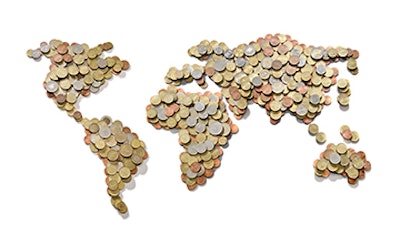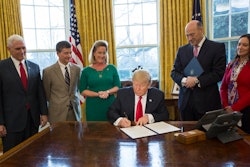
With market globalization, industrialized and developing nations have embraced free trade as a means for opening markets and reducing consumer prices. Yet free trade is also blamed for a lot of the world’s ills including human rights violations, harmful environmental impacts and unintended economic consequences.
The Trump administration appears to be striding toward protectionism to protect the United States from these impacts, but at the same time the potential of this taking place is causing outcry among some who fear it will close off trade from foreign countries, and raises consumer prices domestically.
Supply & Demand Chain Executive recently interviewed key people in the supply chain industry to gather their feelings on this subject, taking a look at the pros and cons of balanced versus free trade, and the Trump administration’s policies when it comes to the North American Free Trade Agreement (NAFTA) and global trade uncertainties, immigration, polices and supply chain impacts, and the Border Adjustment Tax (BAT) and global trade impacts.
In our deep dive into Trump policy, SDCE spoke with: Harry Moser, founder of The Reshoring Initiative, an organization that helps manufacturers realize that local production, in some cases, can reduce their total cost of ownership of purchased parts; Doug Surrett, chief product strategist at BluJay Solutions, a provider of logistics and transportation software and services; Celeste Catano, global product manager and customs expert at BluJay Solutions, a provider of logistics and transportation software and services; David Spooner, a leader in law firm Barnes & Thornburg’s International Trade Practice and former Assistant Secretary of Commerce for Import Administration; Alan Behr, partner in the corporate and business law department, and intellectual property practice, and chairman of the fashion practice at Phillips Nizer; and Arun Pillai-Essex, senior North America analyst at Verisk Maplecroft, a global risk consultancy. Let’s take a look at what our experts had to say.
Q: What are the potential risks of protectionism vs. free trade (or vice versa) on the supply chain industry?
Moser: “The U.S. has been the policeman, the sugar daddy, the bank, for the world ever since World War II. After the war, we were responsible for 50 percent of the world's manufacturing and now we're down to around 20 percent. Some of that was inevitable as other countries recovered, but some was brought on by our not protecting our market. And people have told me about cases where the tariffs on our products coming into another country will be 10 to 15 percent, and the tariffs on their products coming into our country is 4 percent. You've got an imbalance in the terms of trade. What I see happening [with the Trump administration] is an effort to restore that balance to where it should be.”
Surrett: "The U.S. is the world's largest importer and second largest exporter, so we clearly carry a large stick when it comes to global trade. China is certainly the largest exporter in the world and the second largest importer, so it behooves the two countries to be on good terms. But I think a lot of the noise that Trump has been making, certainly in the campaign and even afterwards, was partly to set the table for establishing a more balanced global approach in relationships with more governments—so it’s not just about protectionism or trade. My personal opinion is that the trade discussions, while they're a part of what he's trying to do, are simply a tool in his strategy to change the nature of a number of these relationships."
Catano: "The risk associated with [protectionism] is that other countries can retaliate, adding additional tariffs to our products trying to be exported into those countries, so long term, it may not be good, depending on the industry.”
Spooner: “I think, more than anything else, supply chain executives cringe at unpredictability. Of course, everyone would like to have open markets instead of protectionism, but what really freaks people out, or what really makes it hard to plan, is not knowing what countries might have tariffs next year. Of course, generally, for companies that source globally, it's far preferable both to not have penalty tariffs in place, not to have protectionism and also not to have what are called non-tariff barriers (retaliation from other countries that might result in customs bottlenecks). Right now, with the talk of renegotiating North American Free Trade Agreement (NAFTA) and reevaluating other free-trade agreements, I think we won't see new tariffs or changes in the rules in the next six months. It won't happen that quickly, but I think it makes it hard for people to plan a year or more out. I think virtually all of the companies I work with are holding their breath. They would be opposed to new tariffs, but they also say there are things in old free trade agreements that they wish were better, and maybe this is a chance to fix the problems that we've seen in the past.”
Q: Though the “Trans-Pacific Partnership” (TPP) fell almost immediately after Trump went into office, the way the new administration hopes to change the North American Free Trade Agreement (NAFTA) remain unclear. What is known is that President Trump believes the U.S. has been on the wrong side of this trade agreement for many years and that he has promised changes to it will be needed in order for it to stand. What are the potential risks posed by changing, or even ending, NAFTA and how might this impact global trade?
Spooner: “If you talk to global companies, business executives will quietly tell you that the world has changed in 25 years. And NAFTA really could use some updating. There really could be some positives out of renegotiating NAFTA. We could streamline things at the border and have rules that protect or at least regulate e-commerce among all the countries, etc. That could be a tremendous help to trade.”
Pillai-Essex: “The Trump administration is expected to take a far more measured approach to reforming NAFTA than touted during the 2016 presidential race. U.S. negotiators will seek concessions from their Canadian and Mexican counterparts on protected industries in both jurisdictions, and will strengthen enforcement of U.S. intellectual property regulations. While reform to NAFTA provisions appears to be largely cosmetic, a draft reform proposal does include a call for treaty members to have the right to re-impose tariffs in the event of a flood of imports that cause ‘serious injury or threat of serious injury’ to the domestic industries of another member. This provision injects an element of volatility as it would allow NAFTA members to impose ad-hoc unilateral tariffs. While the imposition of selected tariffs could disrupt cross-jurisdictional supply chains, any tit-for-tat escalation between members is highly unlikely as it would threaten the entire accord.”
Surrett: “NAFTA has clearly been good for the American consumer, [but] it's been terrible for the producers in America. You could make the argument that, for the average American, the price of the products we buy are much lower than they would otherwise be, so in that sense, it's been very good. But at the same time, it's taken a lot of manufacturing jobs and a lot of middle-class wages out of our economy. I'm not convinced that Trump is necessarily trying to undo all of that as much as he is trying to shape other policies and use the trade agreement as a way of bringing people to the table.”
Catano: "The Trump administration wants to renegotiate NAFTA basically because a lot of pieces of NAFTA are not helping the U.S. government, or U.S. citizens, by taking away a lot of jobs, and bringing jobs to Mexico and Canada. We still haven't seen what parts of NAFTA that he wants to really change and whether that's going to have an actual effect long term. It may help companies short term by allowing them to build up their own companies, but long term it could really have a negative effect because all of the companies that rely on exports to, say, Mexico may not be able to export their products to Mexico, and they'll have to start finding other sources or other countries to export their goods to.”
Q: If news reports are accurate, the Trump administration reportedly has dropped any support for a border adjustment tax (BAT) on imports. If enacted the BAT would have imposed levies on billions of dollars on imported goods. Though for now, this seems to be a moot point, we’ve already seen the administration go back and forth on proposed policies in other areas, so it’s still a topic on everyone’s minds. In your opinion, what are the potential risks of a 20 percent border adjustment tax and how would this impact global trade?
Spooner: “There's sort of an unresolved debate as to whether the border-adjustment tax would impact supply chains, but people are certainly concerned about it. It’s probably not very helpful. We don't have a draft of the legislative text yet, but the border-adjustment tax in theory would not tax the corporate earnings from sales overseas and not allow companies to deduct from earnings costs spent on importing stuff. Basically, it would encourage exports and penalize imports. Most of the companies I work with are strongly opposed to the border-adjustment tax. They think it would make their corporate taxes go way up to the point of some of them becoming unprofitable. The corporate folks are fighting with the economists, who believe if a border-adjustment tax is imposed, the value of the dollar would adjust and it should have no net effect on corporate income taxes.”
Moser: “The border-adjustment tax could provide roughly $1 trillion of tax revenue over 10 years, which is needed to offset the corporate tax rate reduction from 35 percent to 15 percent. Now some people say the dollar will go up enough to counterbalance its effects and it will not improve our competitiveness situation. I think they're wrong, [but] the only way to find out is to do it. There's a lot of concern that if you impose that tax, retail prices will go up by 15 or 20 percent. First, they won't go up that much because internal U.S. retail costs won't go up. So you don't have to raise the retail price proportionally. And there will be competition to maintain shares. It will go up a lot less than that, but still will have an impact on anybody who imports a lot.”
Pillai-Essex: “The prospect of a border-adjustment tax—effectively a 20 percent tax on all global imports that would be put in place through a wider tax overhaul—is highly unlikely. The proposal has drawn significant opposition from Senate Republicans and industries contingent on imports. The Trump administration has, in turn, been lukewarm in its support of the proposal. If implemented, U.S. industries, particularly those reliant upon low-cost global imports, will be forced to make tough choices in order to absorb the higher cost. Increasing consumer prices is one option; the other one is to cut their workforce—neither option is particularly appealing to a White House that has promised to create jobs and improve living standards. The U.S. dollar would have to appreciate significantly to absorb the rise in import costs. If it fails to do so, the higher production costs will be passed on to consumers. Finally, foreign firms selling to the U.S. market would be at a disadvantage compared with their U.S. counterparts, as the higher tax burden would make their products less competitive.”
Catano: "I think it's very similar to protectionism. If [the government] starts imposing a border tax, other countries are going to start doing the same and then the cost of the products coming from those countries will be prohibitive to the American people. Because Americans want those products, supply chains are going to have to start looking for other sources of those goods. Then if we want to do any trade with Mexico, we're going to have to price our products in such a way that it'll work; then the Mexican government will retaliate with their own tax. It could be very cyclical.”
Q. On May Day, we saw rallies across the U.S. against the Trump administration’s get-tough policy on immigration, a crackdown protestors claim preys on vulnerable workers in some of America's lowest-paying jobs. What are the potential risks of changes to U.S. immigration policies and how might this impact the supply chain industry?
Pillai-Essex: “One of the pillars of President Trump’s America First policy is taking a stronger stance in limiting migration, both undocumented and legal immigration. This was exemplified by the administration’s pledge to construct a border wall with Mexico, the release of an executive order on refugees and visitors from seven Muslim-majority countries, and the publication of plans to expand programs to locate and deport undocumented workers … Businesses voiced their concern over a stricter approach to immigration. Undocumented workers are one of the largest sources of labor across the U.S. Given their dependence on migrant and undocumented labor, sectors like construction, agriculture and retail could face higher operating costs and disrupted supply chains as a result of the stricter enforcement of current laws.”
Catano: “If the immigration laws are tightened and fewer illegal immigrants come into the country, the industries that rely on illegal labor will end up having to raise their costs to hire legal residents [because] they would have to pay them more than what they typically pay illegal laborers, so I think we'll see an increase in cost. If we have to raise the prices here, then the cost of goods to global partners would end up increasing as well.”
Behr: “People are justifiably worried about their jobs. When someone comes in and says, ‘I'm so desperate for work. Forget the $15 minimum wage—give me $10,’ I think the only way any of this can work with protectionism is still to protect the authenticity of labor, which is to say, you have to show up legally. You have to then be paid a fair wage, with benefits, on the books.”
Surrett: “The supply chain industry is a very adaptive industry and it's going to find a way to work with whatever cards are dealt to it. [Immigration policy], naturally, is going to have an impact, but I would argue it'll probably be somewhat short-lived in that companies are going to find ways to do things with fewer people. They're going to look for automation; they're going to look for opportunities to do things more efficiently so that the rising labor cost can be mitigated. I have a lot of confidence in the folks in this industry that adapt and find ways to work within the confines of the laws and the policies established by any administration.”















